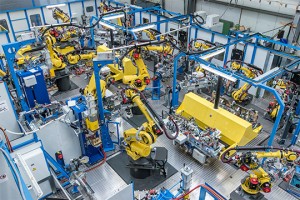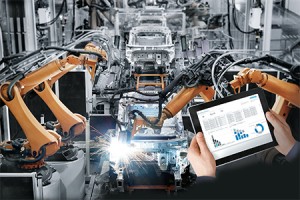Digitalise for productivity gains and climate neutrality
 There is potential to further increase productivity even in automated production. Digitalisation is the key word; smart data analysis provides the tool – and the environment benefits as well. At Automatica, which will be held at Messe München exhibition centre from June 21 to 24, 2022, visitors will get to see a number of use cases.
There is potential to further increase productivity even in automated production. Digitalisation is the key word; smart data analysis provides the tool – and the environment benefits as well. At Automatica, which will be held at Messe München exhibition centre from June 21 to 24, 2022, visitors will get to see a number of use cases.
Take a modern, extensively automated production facility, collect data from various robots, handling systems, and machines and evaluate this data. When combined intelligently, this information has the potential to increase output by 15 to 25 percent without any additional investment in hardware.
As an example, a German car manufacturer collected and analysed data from its almost 400 robots deployed in the body-in-white shop at one of its plants, and then used algorithms to correlate this data with environmental information – even including weather data. The findings were insightful and, among other things, led to changes in the welding parameters for joining hot-formed steel.
The result was an increased hourly output from 18 to 21 car bodies. And in the future, the intention is that such data is intended to be used in plant self-optimization or to detect imminent faults.
A second example is another body-in-white shop application at a premium car manufacturer and involves Festo. Its systems specialists installed additional software on the robot cell’s existing plant PCs that collects diagnostic data from the welding gun and sends it to a cloud interface. The cloud runs a maintenance application that doesn’t just display this data in the browser on a maintenance dashboard, but also estimates the expected remaining service life using artificial intelligence. With the help of this predictive maintenance system, the car manufacturer was able to reduce welding robot downtime by 25 percent.
 So, what does it take to unlock such efficiency gains? This question will be answered at Automatica, but it is clear that automation ‘hardware’ is already digitalisation-enabled. For example, it continuously collects data while welding, picking, assembling, and handling, thus creating the ‘raw material’ of the digital world—and a substantial amount of it.
So, what does it take to unlock such efficiency gains? This question will be answered at Automatica, but it is clear that automation ‘hardware’ is already digitalisation-enabled. For example, it continuously collects data while welding, picking, assembling, and handling, thus creating the ‘raw material’ of the digital world—and a substantial amount of it.
Peter Pühringer, managing director of Stäubli Robotics, said: “Our robots provide all the data required for AI-based tasks and self-optimizing systems in real time. Our six-axis robots can continuously provide around 2,000 different pieces of information, including operating temperatures of each axis, speed and acceleration values, torques, and much more.”
This large amount of data not only enables users to monitor the robot performance and integrate it into digital predictive maintenance concepts. The data can also be passed on to other machines and integrated in higher-level IT systems. And today’s robots are equipped with the interfaces requires for that.
Interfacing requires standards such as OPC UA, a protocol used for communication across machines. Fanuc uses a wide variety of communication protocols such as OPC UA and MTConnect servers, both at fieldbus level and to interface with higher-level IT systems. The Japanese robot manufacturer also supports industry-specific protocols such as UMATI, which is commonly used in metal-cutting production. Among other things, it enables direct interlinking of machine tools and robots.
Open interfaces also play a role in the development of Kuka’s new robot operating system and digital ecosystem. They are at the core of efforts to ensure that iiQKA enables everyone to access the world of automation – whether expert or not. The operating system is based on a modular software architecture. Developed by users for users, the new system software will make robot deployment faster, more efficient as well as accessible and easy to use for all. Usability is its core value.
As such concepts become a reality, users must also set up the appropriate IT infrastructure along with automated production facilities. What that means specifically: They will have to use edge computing and cloud computing as very large amounts of data are involved. And – as illustrated by the use cases outlined above – they will have to use artificial intelligence to comprehensively evaluate the data.
Those who consistently invest in digitalisation will be rewarded – for example, through significant efficiency gains. Products find their own way through production facilities. Machine components automatically detect and report wear and irregularities. And plants optimise their operation independently. This unlocks highly automated production of small series and unique products at greatly reduced cost – just to give another example. And that is part of Industry 4.0’s core concept.
Volker Spanier, head of robotic solutions at Epson, points out another aspect: “According to a study by the Bitkom industry association, digitalisation in production, if implemented consistently, could reduce CO2 emissions in Germany by up to 64 megatons by 2030 – a huge step towards climate neutrality.”
So this entire topic could hardly be more exciting and holds enormous potential in many respects. This is where Automatica in June 2022 comes in: In Munich, visitors will learn how digital transformation will change automated production in the years to come.
Visit the Automatica website for more information
See all stories for Automatica















